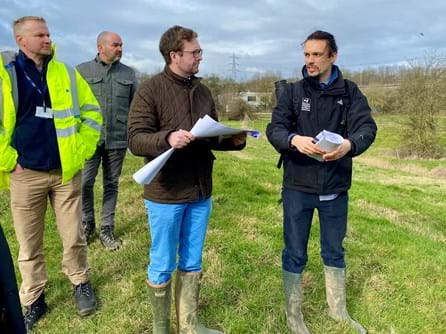Network for Nature - Alexander Stafford MP visits Rother Valley roadside habitat
Published
28 Feb 2023
An £8m initiative between National Highways and The Wildlife Trusts called Network for Nature, to benefit environments previously impacted by road building.
Share this article
A long-term restoration of nature along the River Rother alongside the M1 near Rotherham has been praised by local MP Alexander Stafford.
The Rotherham Rivers 3 project is part of an £8m initiative between National Highways and The Wildlife Trusts called Network for Nature, which will create, restore and connect places for wildflowers, trees and wildlife, where the environment has been impacted by activities from previous road building.
National Highways has awarded over £8 million from its Environment and Wellbeing designated fund into the Network for Nature programme.
The scheme around junction 33 and the Rother is being led by Sheffield & Rotherham Wildlife Trust with backing from a number of partners including National Highways, the Environment Agency and Yorkshire Water.
The Rotherham Rivers 3 project will use natural solutions to alter the flow of the water to provide a variety of habitat and flow types, improving the river for fish and aquatic life. Floodplain work will allow isolated wildlife upstream and downstream to reconnect, including kingfisher and brown trout and will also hopefully tempt the reclusive water vole to return.
Scrapes and ponds will be constructed, restoring the cut-off flood plains, while the wet habitat around an old oxbow lake will be extended creating a wildlife haven for river and wading birds.
Natural barriers will be placed within the river to break up the water flow to provide a variety of habitat and flow to break up the water flow to provide a variety of habitat and flow types, improving the river for aquatic invertebrates and fish. Hedgerows and trees will be planted, and existing valuable habitats including reedbeds and grassland will be enhanced.

Mr Stafford, MP for Rother Valley, who was shown around the site, said “Habitats in this area used to support much more wildlife but the natural course of the river was heavily modified by industry. Large lengths of it were forced into fast flowing straight channels, reducing the vital wildlife habitat within and cutting it off from the wild wetlands alongside. This latest long-term restoration plan will welcome nature back into the area, which will be wonderful to see. It’s a fantastic scheme and it will be interesting to chart its progress and subsequent success.”
National Highways Regional Director for Yorkshire and the North East Simon Boyle said “In England, the roadside estate is vast and yet is adjacent to some of our most precious habitats. When situated alongside linear infrastructure, such as motorways, habitats can create crucial corridors for pollinating insects, birds and small mammals, enabling wildlife to move through the wider landscape. We’re committed to working with partners such as Sheffield and Rotherham Wildlife Trust and the Environment Agency to significantly improve biodiversity near our road network, and this project is a great example of bringing nature back.”
Roy Mosley, Head of Conservation and Land Management, Sheffield & Rotherham Wildlife Trust said "This is a very exciting project to be involved with at a time when our aquatic ecosystems are under more pressure than ever. We will breathe life back into the depleted River Rother and its floodplain, resulting in a more natural river and floodplain that will support a range of aquatic and wetland wildlife."
Anthony Downing, Catchment Coordinator at the Environment Agency said: “The River Rother has a long history of being physically modified to improve drainage or power industry but these changes have often had a negative impact on natural river habitats. In the Catcliffe area, the river has been adapted to provide vital flood storage areas to protect people downstream in Rotherham and Doncaster from the risk of flooding. These works are part of a long term project to create habitats and make more space for nature, creating a healthier environment for local communities while maintaining protection from flooding.”
